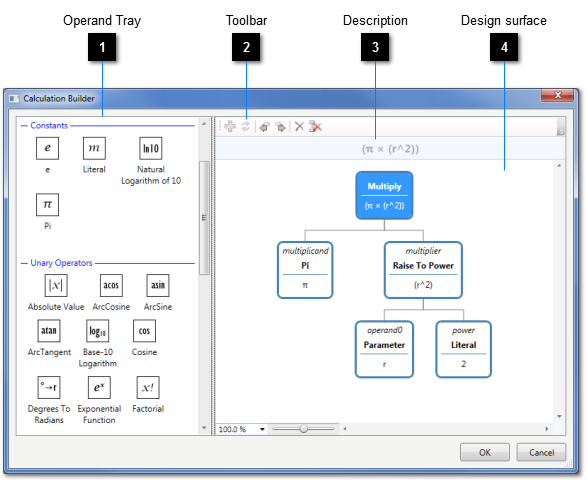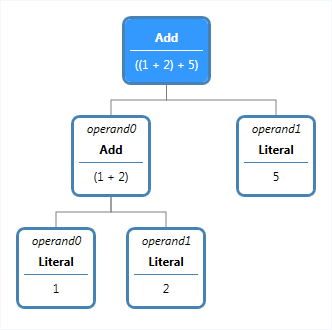The Calculation Builder dialogue is most commonly used in conjunction with the Formula feature. It facilitates the creation and maintenance of mathematical expressions without the need to understand any proprietary syntax, operator precedence, use of parentheses and the like.
 Operand Tray
The list of available operators and operands that may be combined on the design surface when building a mathematical expression.
|
|
 Toolbar
The toolbar supports various design surface actions. |
|
 Description
A representation of the current mathematical expression.
|
|
 Design surface
The design surface on which you build your mathematical expressions.
|
|
Mathematical Expressions
Mathematical expressions take the form of a hierarchy of operators and operands. An operator is a mathematical operation that uses one or more operands to calculate a value. An operand is a value on which a mathematical operation is performed. Importantly, an operand can itself be an operator, meaning that its value must be calculated.
For example, the following expression has two "add" operators and three constant values (1, 2 and 5):
y = 1 + 2 + 5
The first operator adds 1 and 2, then passes the result (3) to the second operator, whose job is then to add 3 and 5.
In the Calculation Builder, such an expression would look like this:
In Absyntax there are two kinds of operators: unary operators and binary operators. Unary operators have just one operand. An example is the Square Root operator. Binary operators have two operands and the Add operator is such an example.
An operand of high importance is the Parameter. Parameters represent inputs to an expression that must be supplied before the expression can be evaluated. You assign a name to each Parameter. Multiple parameters may appear in the node hierarchy and parameters with the same name can also be used. Where multiple Parameter nodes share the same name, they will be assigned the same value when the expression is evaluated.
Finally, there is a group of operands whose values are fixed. Such operands are known as constants. The values of most of these operands are defined by Absyntax; the Literal operand, though, yields a value that is defined by you.
The root node in the hierarchy embodies the overall expression. When an expression is evaluated, the root node is evaluated first. If it is an operator then each of its operands is evaluated before the operation defined by the operator can be performed. This rule is used to resolve each and every node in the hierarchy.

